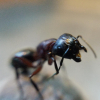I am a Korean antkeeper who is currently keeping 2 Ectomomyrmex javanus queens.
They're a semi-claustral species, so i have them placed in a tubs&tubes setup, and feed them 2 mealworms per week(not superworms). These queens were captured last September, and is known to lay eggs after hibernating. And they are laying eggs, which are long and cylindrical in shape.
these ants are not widely known in the antkeeping community, or even the field of myrmecology itself. Even experienced korean antkeepers have a hard time starting a colony of these Japanese needle ants from scratch, from queen to colony. They mostly collect wild colonies if they want to have these, as they also have a inner gamergate system. I doubt that someone who is looking at my post right now has a healthy colony of this species. if you do, that is PERFECT! if not, i still have some questions that people might be able to answer. I think there might be species that are relatively similar, meaning that some might know the answers to my mysteries.
1. They started laying eggs around 2 weeks ago, and each of them stopped laying at the count of 6 and 3. They seem to tend to the eggs, holding it in their mandibles and moving it around. Though most eggs hatch into larvae within 1~2 weeks, none of their eggs hatched into larvae yet. I do not have any heating cables, but it is not freezing here either. The eggs are cylindrical in shape, and longer than most ant eggs. Do species like this take a longer time to hatch? or is it that they just might be infertile?(All of them had their wings attached upon discovery, but immediately shed them after being transferred into a test tube.
2.Are two mealworms enough for species like this? they are quite big and seem to be fed more, but i do not know how much might be needed for them, as i am running low on mealworm supply due to the pandemic.(Side question; are there any safe alternative 'human foods' that I can feed them for protein?)
3.What is the reason for them to limit the number of their eggs? is it stress? insufficient protein?I currently have them on top of my antkeeping desk- should i move them into a closet like my other species of ants with test tubes setups?
4.My queen with six eggs always seem to be holding all six eggs in her jaws except for when she is feeding. Why might she be displaying this behaviour?
I am excited to keep and learn about a new species, but i still need a lot of help as a mediocre antkeeper in training.
That is all for now, and I thank you all in advance.
















